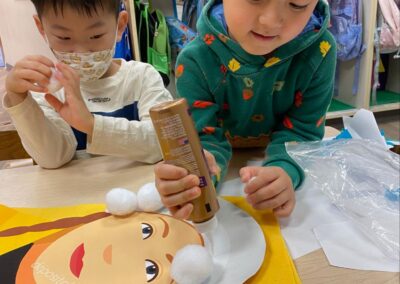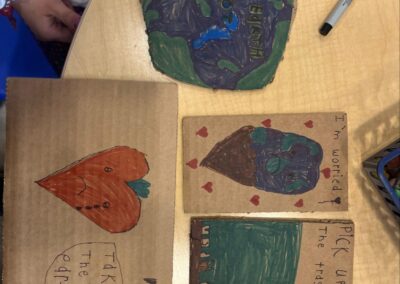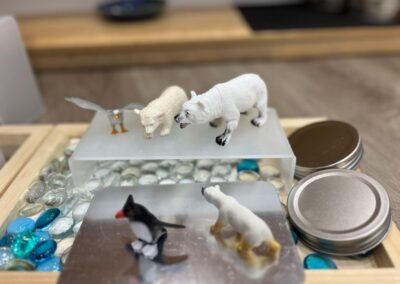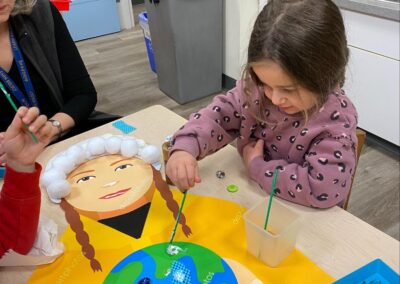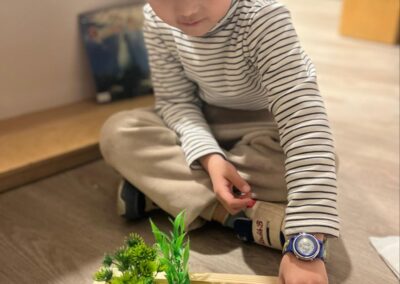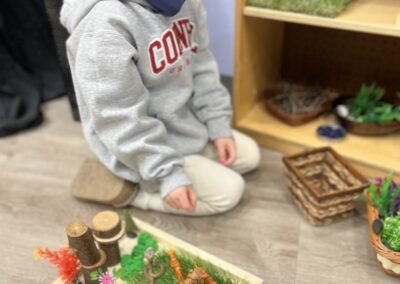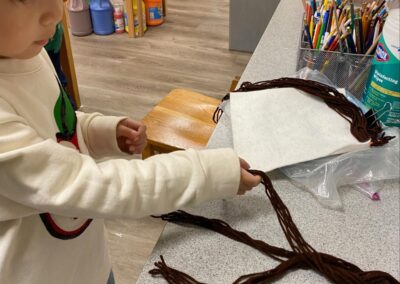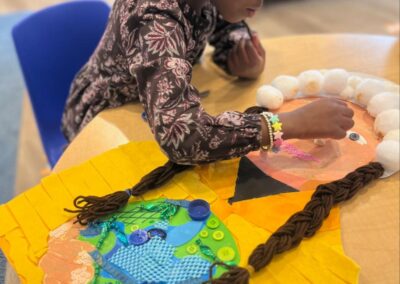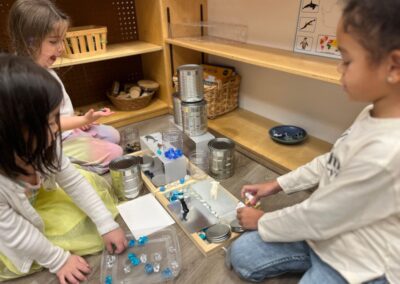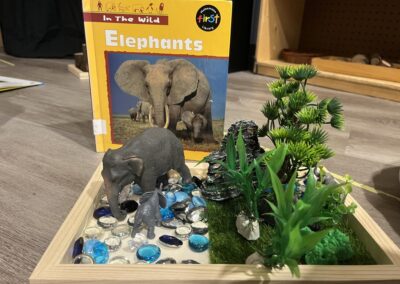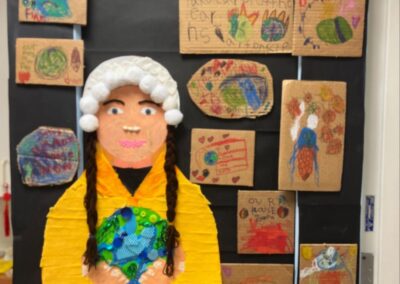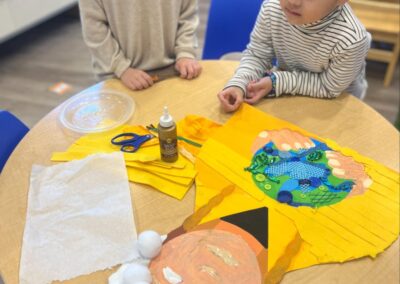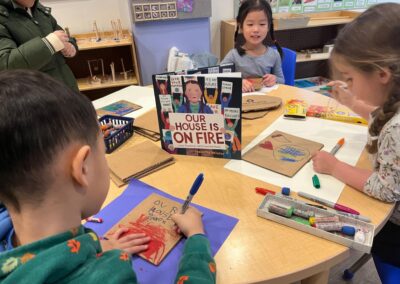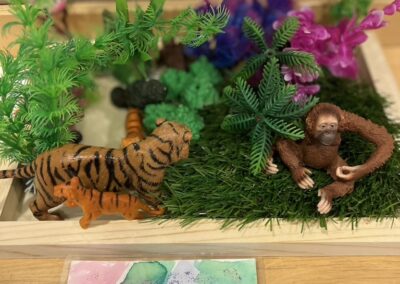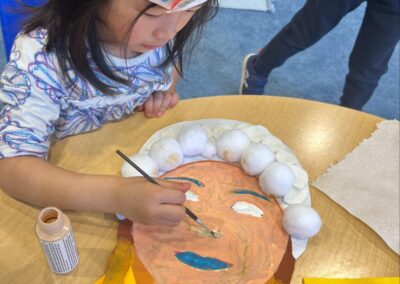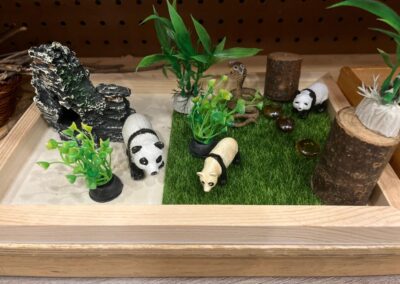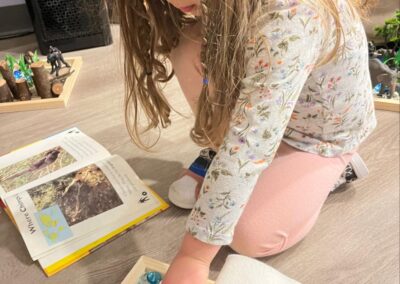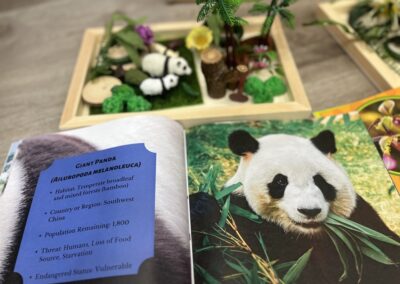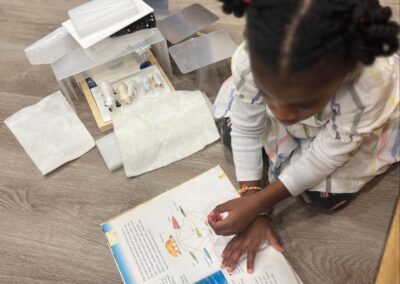Preschool 4 kicked off Women’s History Month by learning about Greta Thunberg, a young climate change activist with a call to action that has inspired young people around the world to use their voices to speak up for change and protect our planet.
Through various readings, discussions, and activities the children are developing an understanding of activism, sustainability, and conservation. Following their curiosity around animals and geography, the children are also exploring animal habitats. Through play, the children are developing an authentic understanding of the impact climate change has on endangered species and the importance of conserving natural habitats around the world.
Collage Portrait of Greta Thunberg
Our journey began in the art center, where the children collaged a portrait of Greta Thunberg, using repurposed materials such as plastic caps, yarn, fabric scraps, and seashells to showcase the importance of recycling and reusing materials. Some children learned how to braid to create her hairstyle, while others focused on mixing colors of our class-made skin tone paints to match her skin.
Documentation of Our Learning Through Book Discussions
To learn about environmental responsibility, we read Go Green with Greta by Eliza Brookfield, a rhyming book that emphasizes ways we can “go green” following the three R’s – reduce, reuse, and recycle. Inspired by the book’s message that every individual can make a positive impact, we discovered ways we can do our part in caring for the planet:
- Respect nature by being mindful of our actions outside
- Help others through donations
- Reduce waste through recycling
- Conserve energy by turning off the lights and water
- Reduce plastic use and opting for reusable materials
- Composting food scraps
- Participating in neighborhood cleanups
Our preschool activists practice repurposing materials like caps in their art projects, and recycling plastic after snack and lunch. As a class, we have been brainstorming ways to be more mindful of our electricity and paper use in the classroom. Kaan suggested, “turn off lights in the bathroom when we go out.” Some students made connections to their practices at home; after learning the term “second hand,” Eleanor shared,” Like when my brother was little he had a white shirt and he got too big and I can wear it now.” Olivia added how donations also help others, “When my baby [sister] has too small clothes, we give them away to people that don’t have clothes. I give toys away to people that don’t have them too.” In April we will participate in a campus clean-up with the Environmental Club.
Our House Is on Fire by Jeanette Winters
To learn more about Greta’s journey as an activist, we read Our House Is on Fire by Jeanette Winters. Throughout the story, the children shared what they noticed or wondered about the powerful messages and detailed illustrations.
Noticing the illustration and message about coral reefs, Sydney shared, “They were all different colors before [global warming] but now they aren’t anymore.” Making a connection to the previous conservation about the earth being “sick,” Eric applied this idea to ocean coral: “When they lose colors and stuff, that means they get sick!”
Thinking deeply about the messages and illustrations about the oceans and forests, Brandon asked “Why is that happening?” As a class we revisited the connection between how climate change and global warming affect different parts of the world. Lexi quickly offered her thoughts, “Ice [is melting]!” Noticing the next illustration, Autumn added “the trees are on fire.”
Activism – Sign-Making Activity
Our preschool activists responded to the big question posed by the author – “WHAT WILL YOU DO?” by making signs to raise awareness about climate change, and express their thoughts and feelings about the environment. We revisited the title of the book and thought about what “our house is on fire” means; is a house actually on fire? Noelle shared, “It’s all of our homes, because we all live on earth.” Thinking about the difference one person can make, Albert shared, “We could think about something we can do.”
Endangered Animals – Building Habitats
Earlier this month in the building center, we created an “animal habitat” provocation, setting out a variety of materials and loose parts such as wood discs, sand, twigs, small blocks, glass tiles, water beads, plants, fabric, and animals. We also set out different non-fiction books about animals to support the children in their exploration.
Using their imaginations, they created homes and habitats for various endangered animals such as sea turtles, polar bears, pandas, tigers, elephants, orangutans, and chimpanzees.
Through fictional stories we read as a group and their own research using nonfiction books in the building center, the children’s ideas have evolved as their knowledge of climate change expanded. Observing and documenting their questions and conversations as they built collaboratively, we captured their growing understanding of what it means when animals are endangered. Luna explains, “[Extinct means] well they might die or they might not have any food so we have to try to help them. We can speak up for them, and we can look for their real home, and they will say thank you.”
The children also made connections to the global ocean, recycling, and reducing plastic. One idea for helping globally included Zoey’s idea: “I will make more ice so the polar bears will live.
Through these activities, readings, and discussions the preschool-4 students are developing an authentic understanding of environmental responsibility and the role they can play in caring for the earth.


